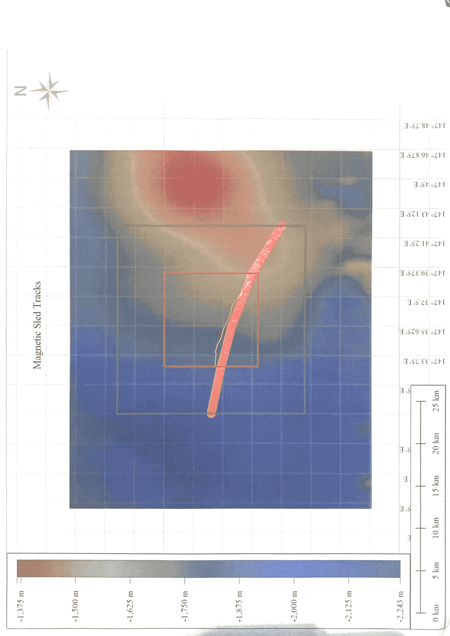We Have Discovered Spherules from the Path of the First Recognized Interstellar Meteor, IM1
Diary of an Interstellar Voyage, Report 20 (June 21, 2023)

Jeff Wynn ran down the stairs to tell me: “Ryan Weed found a spherule under the microscope.” I ran up the stairs and saw the image of a spherule, 0.3 millimeter in size, looking like a metallic pearl on the background of volcanic ash. It felt like finding an ant in the kitchen. When you find one, you know that there must be many more. Indeed, I could find many more metallic spheres in the same microscope image.
I congratulated the team for the discovery and urged Ryan to immediately place the spherule in the X-ray Fluorescence analyzer to get its composition. We found a composition of mostly iron with some magnesium and titanium but no nickel. This composition is anomalous compared to human-made alloys, known asteroids and familiar astrophysical sources.

The spherule was magnetic and separated by a filter with a comparable mesh size, so potentially there might be many more spherules in the residue that contains smaller particles. It was collected in Run 8 that went along the upper envelope of the most likely path for IM1 based on the analysis of seismometer data in a paper that I wrote with Amir Siraj three months ago.

Coincidentally, Amir arrived at Silver Star just when the spherule discovery was made. This provided perfect timing for Amir to get engaged in finding many more spherules of different sizes and surveying the literature for how anomalous their composition is.
The magnetic nature of the spherules implies that we do not need the sluicing device and can continue using the magnetic sled for the coming week. Finding more spherules will allow us to pinpoint the meteor path and potentially seek a large object that may represent its core at the end of the path. If such an object is retrieved, its structure could inform us of its technological purpose and design.
The metallic pearl-looking spherules are embedded in the volcanic ash and so our goal from now on is to retrieve all the magnetic material available on the sled magnets in the form of black powder and then identify the metallic pearls and separate them with tweezers. Ryan Weed, Jeff Wynn, Charles Hoskinson, J.J. Siler and Amir Siraj are all engaged in this effort.
Proving that we can get the magnetic sled on the ocean floor allowed us to do it again and again and find materials from IM1’s fireball site. Proving that we can retrieve the first spherule from that material allows us now to do it again and again and find a large number of spherules from IM1 in a consistent and systematic fashion.
We are now on our way back to IM1’s crash site in an attempt to retrieve as many spherules as possible. With a large enough sample, we can obtain a gamma-ray spectrum that will characterize its radioactive elements and potentially date the sample. Constraining the travel time might allow us to identify the distance and direction of its source star given its known velocity. Our preliminary analysis implies that the composition of mostly iron with a tenth of that in magnesium and some titanium does not resemble known human-made alloys or familiar asteroids.
The fundamental question is obvious: was this first recognized interstellar object from 2014 manufactured by a technological civilization? Upon our return, we could produce an alloy in the laboratory that has the same composition as we infer for the spherules and analyze the resulting material properties.
I secured space to store all the retrieved materials at the Harvard College Observatory, and analyze its elemental and isotopic composition with state-of-the-art diagnostics. My daughter, Lotem, who was just admitted to Harvard College, will take part in this analysis as a summer intern.
Before I left Harvard, one of my colleagues whispered: “Many people here argue that you are wasting your time in leading a hopeless expedition to the Pacific Ocean, but although I agree that the chance for success is small — I hold the opinion that the search might be just worth trying.”
As the philosopher Arthur Schopenhauer noted: “All truth passes through three stages: First, it is ridiculed; second, it is violently opposed; and third, it is accepted as self-evident.”
Gladly, the discovery of IM1 spherules of anomalous composition moves the discussion to the third stage. Given that, some colleagues might add another stage: “… and fourth, I said it first.”
ABOUT THE AUTHOR

Avi Loeb is the head of the Galileo Project, founding director of Harvard University’s — Black Hole Initiative, director of the Institute for Theory and Computation at the Harvard-Smithsonian Center for Astrophysics, and the former chair of the astronomy department at Harvard University (2011–2020). He chairs the advisory board for the Breakthrough Starshot project, and is a former member of the President’s Council of Advisors on Science and Technology and a former chair of the Board on Physics and Astronomy of the National Academies. He is the bestselling author of “Extraterrestrial: The First Sign of Intelligent Life Beyond Earth” and a co-author of the textbook “Life in the Cosmos”, both published in 2021. His new book, titled “Interstellar”, is scheduled for publication in August 2023.
